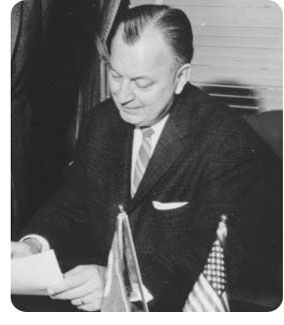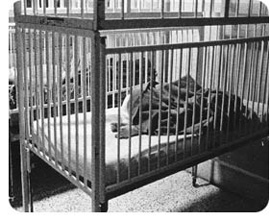In 1955, the Legislature created an Interim Commission on Handicapped Children, chaired by then-Senator and future Governor Elmer L. Andersen. Future Governor Al Quie served as Secretary.
After meeting 16 times in 1956, the panel reported the landmark conclusion: "It is the right of every child to have equal opportunity for education with every other child."
Video: Maynard Reynolds, former Chair, University of Minnesota, Department of Special Education, speaks of his role with an interim legislative commission to study the needs and problems in Special Education.

Governor Elmer L. Andersen: Every child should have equal opportunity for education.
In 1957, responding to the Commission's conclusions, the Legislature passed mandatory special education opportunities for students with IQs of 50 or higher, as well as educational opportunities for students with physical disabilities. It also authorized state aid.
Schools also were permitted to serve children with IQs below 50.

By the late 1950s, the state had mandated that special education opportunities be made available to most children.

Video: Interview with
Former Governor Al Quie
Part 1: Former Minnesota Governor Al Quie reminisces about the 1956 Legislative Commission to study children with disabilities, statewide hearings, and the Commission's decision to focus on children deemed educable.
Part 2: Former Governor Al Quie talks about his years of service in Congress, as a US House member, during the passage of the Education for All Handicapped Children Act (P.L. 94-142).
Part 3: Former Governor Al Quie discusses the future of special education and related funding issues.
Article: State Policy Grew out of a Spiritual Journey
In 1957, the Legislature created the Advisory Board on Handicapped, Gifted and Exceptional Children. Governor Orville Freeman appointed Dr. Maynard Reynolds as the Board's chair.
By June 1958, the Board reported that 19 classes in the state were available to students with IQs below 50. Ironically, parents were still encouraged to commit their children to state guardianship.

Governor Orville Freeman: Pushing for Change
When asked to summarize the Department of Public Welfare's major achievements from 1955 to 1960, Dr. David Vail, medical director, singled out the volunteer services of over 2,000 individuals.
He also noted that the number of special education classes available in the state had increased to 32 classes for children with the lowest IQs and 380 classes for those with "educable" diagnoses.
Dr. Vail was a leader in the area of human rights and finding ways to improve conditions in the state institution system.

Dr. David Vail
While community placement options were expanding, the state institution system continued expanding as well.
A state-run facility opened in Brainerd in 1958, the same year the Cambridge hospital expanded. In addition, 45 of Minnesota's 87 counties created Advisory Councils for those labeled "trainable."
Even though the waiting list for state institution residency continued to grow, a quarter of the families with children with developmental disabilities ultimately rejected placing them in institutions. And, for the first time, parents received a small amount of funding under the new "Aid to the Disabled" program.

The state's institutional care system grew to include a new Brainerd facility and an expanded hospital in Cambridge.
In his annual report to the Commissioner of the Department of Public Welfare, Dr. Vail described an emerging community philosophy, repeating the ideas expounded by Governor Youngdahl more than a decade earlier:
"All people are equal with equal human rights and dignity and local communities should be providing the services that people need."
He also said that while community care is preferable, it is not adequate on its own. Because all people are individuals, some will not fit into community facilities and additional options needed to be made available.

All people are equal, with equal human rights and dignity.







